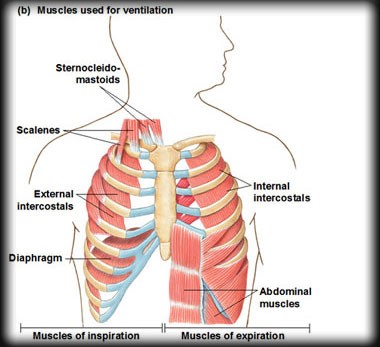The primary muscles that control breathing are the intercostal muscles, which lie in between the ribs, and the diaphragm which draws air into the lungs.
Inspiration can occur due to inspiration muscles that create space in the thoracic cavity for air to be drawn in. The External intercostal muscles help with lifting the rib cage while the diaphragm lowers down to create a pressure gradient. Both of these functions allow air from outside of the body to be drawn inside the lungs.
Secondary inspiration muscles help to raise the rib cage. Muscles around the neck that attach to the rib cage such as the sternocleidomastoid and scalenes lift the rib cage. The pectoralis minor which attaches to the 3rd, 4th and 5th rib and the coracoid process of the scapula also help to raise the rib cage for more air space.
Expiration during quiet breathing occurs passively without muscle contraction. The elastic recoil from the inspiratory muscles, the rib cage, and diaphragm push the air out.
Forced expiration uses muscles of the abdomen to pull the rib cage down and compress the abdomen and forcefully push the air out. The internal intercostals also pull the rib cage down forcing air out.

References:
Muscles of Respiration. (n.d.). Retrieved July 16, 2018, from https://www.physio-pedia.com/Muscles_of_Respiration